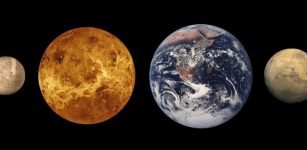Black Hole or Newborn Stars? – Galactic Puzzle
Eddie Gonzales Jr. – MessageToEagle.com – In a new study, scientists are puzzled by a black hole that seems to be changing its galactic surroundings in a way that is usually associated with newborn stars.
Black holes are inherently strange, with gravitational forces so strong that nothing, not even light, can escape. As active black holes consume gas and dust, some of that material is instead launched outward as jets of high-energy particles and radiation.
 Artist’s concept of a jet from an active black hole that is perpendicular to the host galaxy (left) compared to a jet that is launching directly into the galaxy (right) illustrated over an image of a spiral galaxy from the Hubble Space Telescope. SOFIA found a strange black hole with jets that are irradiating the host galaxy, called HE 1353-1917. Credits: ESA/Hubble&NASA and NASA/SOFIA/L. Proudfit
Artist’s concept of a jet from an active black hole that is perpendicular to the host galaxy (left) compared to a jet that is launching directly into the galaxy (right) illustrated over an image of a spiral galaxy from the Hubble Space Telescope. SOFIA found a strange black hole with jets that are irradiating the host galaxy, called HE 1353-1917. Credits: ESA/Hubble&NASA and NASA/SOFIA/L. Proudfit
Usually, these jets are perpendicular to the host galaxy, but NASA’s Stratospheric Observatory for Infrared Astronomy, or SOFIA, found one that is shooting directly into its galaxy.
That jet is heating up gas around the galaxy’s center in a way that’s characteristic of stars being born. This is prompting scientists to reevaluate their ideas about a key gas associated with baby stars, and about how black holes affect their host galaxies generally.
“The black hole’s jet orientation is so peculiar,” Irina Smirnova-Pinchukova, a scientist at the Max Planck Institute for Astronomy in Heidelberg, Germany, said in a press release.
“It transforms the surroundings in the same way newborn stars would, but stars alone could not cause what we observed.”
Stars are born deep inside celestial clouds of dust and gas, a process hidden from our view in visible light. But infrared light, which our eyes cannot see, can penetrate these clouds. SOFIA, for example, uses infrared light to study how stars are born. But even with powerful telescopes, astronomers cannot see details like newborn stars in extremely distant galaxies. Instead, they hunt for signatures of gas that is heated by newborn stars, called ionized carbon.
Because ionized carbon is so often found in connection with newborn stars, scientists often assume star formation is occurring when they find the gas in distant galaxies.
But when scientists on SOFIA studied five nearby galaxies with active black holes, they discovered that the one with the lowest rate of star birth contained the most ionized carbon. In fact, there were 10 times more than in other galaxies of similar size and composition. But the star-birth rate is so low that it can only produce 25% of the gas they detected. In other words, newborn stars alone could not explain the abundance of ionized carbon. There must be some other explanation for this important chemical signature.
The team used SOFIA’s instrument called the Field Imaging Far-Infrared Line Spectrometer, or FIFI-LS, to closely examine the galaxy, HE 1353-1917. They found that the black hole’s jet is shooting radiation directly into the galaxy, rather than into the space surrounding it. Most of the ionized carbon is concentrated near the galaxy’s active black hole, indicating that the mysterious source of the gas is the intense radiation the black hole’s jet generates.
This contradicts the long-held assumption that ionized carbon is primarily a signature of newborn stars.
“Without numerous observations of nearby galaxies, we might not find such exceptional cases where a black hole is a source of ionized carbon,” said Smirnova-Pinchukova.
“This gas is one of the most important tools we have for studying extremely distant galaxies that cannot be seen in great detail.”
The results are published in the journal Astronomy and Astrophysics.
Written by Eddie Gonzales Jr. – MessageToEagle.com Staff










![Scientific visualization of a numerical relativity simulation that describes the collision of two black holes consistent with the binary black hole merger GW170814. The simulation was done on the Theta supercomputer using the open source, numerical relativity, community software Einstein Toolkit (https://einsteintoolkit.org/). Credit: Argonne Leadership Computing Facility, Visualization and Data Analytics Group [Janet Knowles, Joseph Insley, Victor Mateevitsi, Silvio Rizzi].)](https://www.messagetoeagle.com/wp-content/uploads/2021/07/artifintelgrvitwaves01-307x150.jpg)